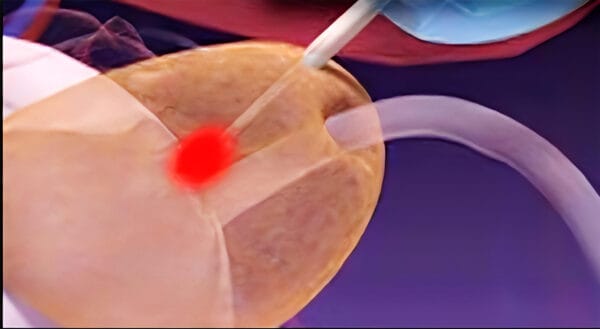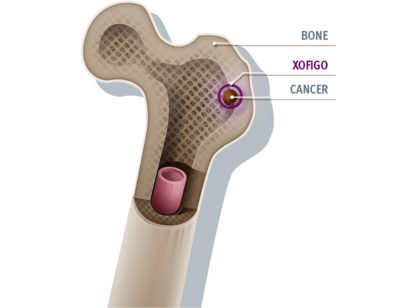According to the American Cancer Society, about 1 in 8 men will be diagnosed with prostate cancer during their lifetime and 1 in 44 will die each year.1
Current therapies for treating the growing disease include active surveillance (wait and watch), total removal of the prostate gland or radiation therapy of the entire prostate gland. Unfortunately, the last two options often result in life-altering side effects such as erectile dysfunction (in up to 50% of patients) and/or urinary incontinence (in up to 25% of cases). 2, 3
“Data to date indicate that outpatient trans-rectally delivered MRI-guided laser focal therapy for prostate cancer has similar oncologic control as whole-gland therapy without the associated morbidity.”
— Chief Research Officer Bernadette M. Greenwood
In May 2010, a team of medical professionals from Indian Wells began a clinical trial for prostate cancer, evaluating the use of trans-rectally delivered laser focal therapy under MRI guidance. The minimally invasive procedure treats only the areas of MRI-visible cancer and preserves tissue to reduce side effects. The study objective was to explore the efficacy of this treatment in an outpatient setting as an alternative to whole-gland therapy. The clinical trial was the first of its kind in the world.
As chief research officer of what was then Desert Medical Imaging, I was a member of that team working with research physicians John F. Feller, MD and Stuart May, MD. The 20-year trial was entitled “Phase II Laser Focal Therapy of Prostate Cancer (LITT or FLA)” and is now in its 14th year.
This May, our team, now operating as HALO Precision Diagnostics, will present our interim results at the American Urological Association’s annual meeting in San Antonio, Texas.
Study parameters
Two hundred men participating in the study were carefully selected based on specific criteria including a Gleason Score of 6 or 7. The qualifying group underwent the 2-3-hour outpatient procedure where a laser probe was placed trans-rectally into the prostate gland. Using MRI real-time temperature imaging, Dr. Feller and a specially trained team targeted and destroyed the cancer by laser without having to remove or radiate the whole gland.
The study group is being observed for 20 years according to research protocol to measure cancer control, sexual function, urinary function and emotional well-being. HALO’s biostatistician analyzes the data and reports regularly on results, which to date, are non-inferior to standard of care prostatectomy and radiation therapy.
Promising results to date
In 2020, our 10-year results were published in the Journal of Urology. Under an IRB-approved, HIPAA-compliant protocol, 158 men and 248 cancer foci were treated, and no serious adverse events or morbidity were reported.
Of the 122 men that underwent six-month biopsies of the treatment site, 26% (32/122) were positive and clinically significant, while 59% (71/122) were negative. The remaining 15% (18) men were positive but clinically insignificant.
While most of the positive results were of marginal recurrence, 5% (6) men had clinically significant incidence cancers. We observed a 37% decrease in mean PSA at 12 months post therapy, and no statistically significant change in the International Prostate Symptom Score (IPSS) which measures the disease severity and response to therapy, or the Sexual Health Inventory for Men (SHIM) score which characterizes the severity of erectile dysfunction.
At 10 years, the metastasis free survival rate was 99%, and the prostate cancer specific survival rate was 100% (the overall survival rate was 98%).
Conclusions
Data to date indicate that outpatient trans-rectally delivered MRI-guided laser focal therapy for prostate cancer has similar oncologic control as whole-gland therapy without the associated morbidity.

Focal treatment of prostate cancer may be an attractive option in a subset of men appropriately risk stratified. The precision and safety achieved using laser focal therapy under MRI-guidance may have a favorable impact on cost effectiveness and quality of life, without eliminating the possibility of whole-gland treatment should the patient’s prostate cancer recur later.
Outside of the trial, HALO Precision Diagnostics continues to offer this unique therapy in the Houston and Indian Wells offices as part of the Focal Therapy Society Outcomes Registry and in keeping with our mission to safely perform the procedure and monitor long-term outcomes.
Other exciting research at HALO involves use of a new MRI contrast agent and the deployment of stem cells under image-guidance.
Bernadette M. Greenwood is chief research officer for HALO Precision Diagnostics in Indian Wells and a PhD candidate at Radboud Institute of Health Sciences. She can be reached at [email protected]. To learn more about their research program, visit www.HALODx.com.
References: 1) https://www.cancer.org/cancer/types/prostate-cancer/about/key-statistics.html; 2) www.medscape.com: Is Focal Therapy the Future for Prostate Cancer? Ahmed and Emberton. Future Oncology.2010;6(2):261-8; 3) www.renalandurologynews.com Focal Ablation May Treat PCa Relapses. Schieszer May 21, 2010.



















































Comments (0)